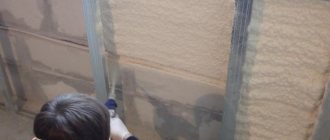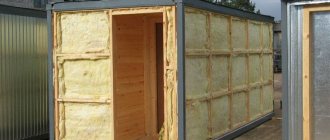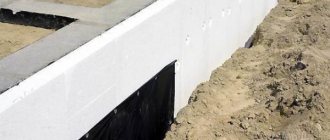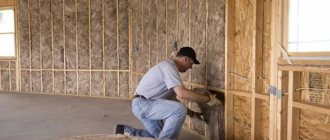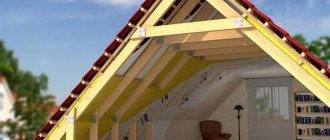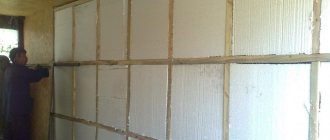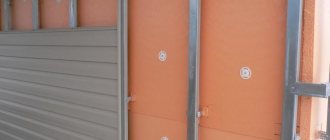The composition of the family and the needs of its members change over time, and this cannot always be taken into account when building a house. At some point it may turn out to be too small: there is a need for an additional bedroom, office or bathroom. You can solve this problem with little expense if you know how to insulate the veranda, turning it into the same warm and cozy room as the rest of the rooms in the house. To do this, you need to select the right materials and create a warm cocoon inside or outside the extension, depending on its design.
The winter veranda will require not only insulation, but also heating Source nasha-besedka.ru
Determining the scope of work
To decide how to insulate an extension to a house with your own hands, you need to evaluate its design, wall material, dimensions, ceiling height and other features:
- If the area of the room is small and you want to preserve it, you will have to insulate the walls from the outside. The same applies to the floor and ceiling, when when insulating from the inside, the distance between them decreases to unacceptable.
- It is not always possible to insulate floors from the outside without dismantling the existing coating. This happens when the flooring is located low above the ground and it is impossible to get to it from below.
- The same applies to the ceiling: if the veranda and the house have a common roof, there are no problems with insulation from the attic. If the extension is closed by one slope with a slight slope, you will have to either dismantle the roofing material or install insulation from the inside.
- Most of the heat escapes through doors and windows, the insulation of which is not given due attention in a room originally intended for seasonal use. Most often these are single-pane windows and lightweight doors. You need to decide whether to replace them or insulate them.
Even such high-quality and new windows will not retain heat in winter Source ankorokna.ru
- The entrance directly from the street is an open gate for frosty air, which manages to cool the room in a matter of seconds. Therefore, it is necessary to think about installing a vestibule, which can be done by fencing off part of the veranda with a warm partition or by attaching an entrance group to it.
- You should also think about the heating method before starting thermal insulation work. If heating is chosen using a “warm floor” system, the floor insulation technology must take into account the installation features of such a system.
Advice! If you do not live in the house permanently, then you should not install a water heating system - it may freeze and fail in your absence. It is better to prefer electric heated floors.
- The material of the walls is also of great importance. It is undesirable to insulate vapor-permeable materials, such as wood or foam concrete, with non-breathable insulation materials, otherwise moisture will accumulate between them, gradually destroying the load-bearing structures and leading to serious disturbances of the indoor microclimate, including the occurrence of mold and mildew.
The result of improper insulation Source e-brus.ru
As for how to insulate a terrace in a wooden house with your own hands, here we are talking more about a complete reconstruction or completion. Especially if it is an open extension without a canopy and a floor raised above ground level. Sometimes this task is even easier to solve, since there is no need to dismantle existing ceilings, old windows, etc.
In general, to transform the veranda into a living space, comprehensive insulation of all structures except the wall common with the house will be required.
Is it necessary to insulate the veranda?
There is an opinion that if you insulate the veranda, the house will become warmer. There is some truth here. The veranda is always located on the side of the house where the entrance is located. The additional room is a barrier to wind, precipitation, and low temperatures. The cold does not immediately enter the house through the entrance doors. However, this protection is minimal. If you initially calculate the costs of thermal insulation of the veranda, it will be cheaper to install reliable insulated doors.
You need to insulate a heated veranda, where a comfortable temperature is constantly maintained in winter
The second nuance is the design of the extension. If this is an open terrace, then there can be no talk of any thermal insulation. She's simply useless. Even if the veranda is glazed, you need to carefully study its structure again. Typically, such extensions are initially built of a cold type. The simplest design has a wooden frame. It is covered with boards. The outside walls are lined with a windproof membrane. The canvas prevents cold wind from penetrating through the cracks. The final exterior finishing is done using a block house or other types of panels. The inside walls are also lined with clapboard. The extension turns out to be cold, but thanks to the windproof membrane, atmospheric moisture and wind do not penetrate into the room.
Now, if you simply insulate a veranda from boards from the inside, then there will be no point. Regardless of the thickness of the insulation, the room will be cold. The insulation must be laid outside and a ventilated gap must be created between it and the block house. Here you need to consider whether it is profitable to tear off the wall cladding, because some panels will become unusable after dismantling.
The last nuance is related to the presence of heating. After insulation, the inside of the room will not become warmer unless a heater is installed. If you don’t want to heat the veranda and insulate it, it makes no sense.
Choice of insulation
Based on their structure, all thermal insulation materials can be divided into 3 types.
Cellular
Such insulation is made from polymers, which are given a special structure in the form of many closed cells filled with air. They are produced in the form of rigid panels, rolled materials and foams, which harden after application to the insulated surface.
Note! Since the basis of such insulation is made up of synthetic chemical components that release toxic substances (phenol, styrene, etc.) when heated or burned, it is recommended to additionally protect them from fire.
In case of fire, people often die not from fire, but from poisoning by toxic combustion products Source rostovgazeta.ru
See also: Catalog of projects of houses with a veranda
This type of insulation includes:
- polystyrene foam and expanded polystyrene, including extruded. These materials have a very low thermal conductivity coefficient, are not afraid of moisture, and therefore do not need to be insulated from it. They are produced in the form of rigid slabs that can be fastened using a frameless method. Expanded polystyrene is also produced in granules, which are poured into the space between the walls of the frame or brickwork, and added to cement plaster mortars. The disadvantages of this insulation include vapor permeability and high toxicity during combustion. The advantages are low cost and ease of installation, which can become the main argument when you need to decide how to insulate a veranda in a private house cheaply with your own hands;
- polyurethane foam is a rather expensive insulation material. It is used in two ways: mounting plates and spraying using special equipment. The second method is more effective, as it allows you to create a monolithic seamless thermal insulation layer without cold bridges;
External insulation of brick veranda walls by spraying polyurethane foam Source i.ytimg.com
- Foamed polyethylene or penofol is a convenient rolled material for additional insulation. There are varieties covered with foil on one or both sides to reflect radiated heat. Penofol in the form of narrow tapes with a self-adhesive layer can be used to insulate windows, attic hatches and other openings, bridging the gaps between the wall and the frame.
Fibrous
With their structure, such insulation is reminiscent of unspun wool or cotton wool, hence the name - mineral wool. The raw materials for its production are various minerals and waste from ore smelting - slag. Therefore, the following types of these heat insulators are distinguished:
- basalt wool;
- glass wool;
- slag.
Solid raw materials are transformed into fibers as a result of special processing. Due to their mineral origin, these materials do not burn, but due to their fibrous structure they easily absorb moisture, losing their thermal insulation properties. For this reason, they require mandatory hydro- and vapor barrier.
Structure of mineral wool Source stroyobzor.info
See also: Catalog of companies that specialize in small forms and finishing materials
If you need to decide how to insulate a veranda for winter living in a wooden house, mineral wool will be the best choice, since it is permeable to steam and does not create an insurmountable barrier to its escape through the walls to the outside.
Available in mats and rolls of varying degrees of density. To insulate horizontal surfaces, you can use any material, but it is better to install dense slabs on vertical surfaces, since they are less susceptible to shrinking and “sliding” down under their own weight.
Review of thermal insulation materials
Don’t immediately think about how to make a warm veranda; first find out what you need to prepare for this. Now there are many different materials on the market that will help to thermally insulate a veranda. They have different prices and performance characteristics. So, what materials are most often used for internal insulation:
- Foam plastic is used most often because it is rigid, weighs little, retains its performance characteristics for a long time and can even be mounted with a frame. The disadvantages include a high risk of fire and vulnerability to rodents. This is a serious drawback if you are setting up a veranda at your dacha. But on the other hand, when using polystyrene foam, there is no need to make another waterproofing layer.
- penofol because it has good characteristics, looks modern and can be used with other types of insulation. Penofol is ideal for country cottages, because it is environmentally friendly and practically does not allow steam to pass through. You can install it yourself without much difficulty.
- Mineral wool is also often used to insulate a building . It is suitable for thermal insulation of any building on a summer cottage. To install such a thermal insulation layer of mineral wool, you will first have to make a frame structure. However, there is one drawback: this material may lose its density after a few years.
- Basalt wool , in fact, is an analogue of mineral wool and it is also used for internal insulation of a room. It is better than mineral wool, and all because it is more environmentally friendly, and therefore safe for health.
- Expanded polystyrene combines all the advantages of foam insulation. It is non-flammable, durable and not difficult to work with, but, unfortunately, it allows various sounds to pass through.
- In terms of elasticity and strength, glass wool It can be bought at a hardware store in the form of a roll, but when working with it, you must use protective equipment. There is one more disadvantage: glass wool begins to sag over time. You can close your eyes to all the shortcomings because this material is fireproof.
Important! Each person decides for himself how to insulate the veranda based on his preferences and financial capabilities.
Video description
The video will tell you about the pros and cons of cellular and fibrous insulation:
Bulk
Expanded perlite and vermiculite, expanded clay granules - these and other thermal insulation fills can be used when the question arises of how to insulate the floor on the veranda or the ceiling from the attic. Such bulk materials are convenient because they create a continuous layer; their particles fall into all the cracks and cover them. They cost less than fiber mats, especially considering that you do not need to install a frame to install them.
To insulate the ceiling, it is enough to fill the ceiling from the attic side with expanded clay Source kakpotolok.ru
Advice from professionals
A common problem for developers is the difficulty of determining which side is more profitable to insulate the walls on the veranda. Professionals advise doing this outside. If the insulation is located inside the veranda, the dew point will shift. The wall material freezes, cold meets heat, and condensation forms. Dampness causes slow destruction.
The location of the thermal insulation determines how destructive the displaced dew point will be for the walls.
When arranging a warm veranda, you must not forget about the windows. It is optimal to install energy-saving double-glazed windows with three glasses. Old doors are also replaced, because a large percentage of heat loss occurs through them.
It is easier to use electric heaters for heating. Power is calculated using the standard formula: 100 W/1 m2 of room.
Insulation technology
Since it is easier to insulate an extension to a house from the inside - you can work in any weather - this method, despite all its shortcomings, is used quite often. Another reason for this choice is often related to the fact that the external walls are already finished with the same facade material as the entire house, and you do not want to spoil the exterior.
There is no big difference in how to attach the insulation - from the inside or outside. There are serious differences only in the thermal insulation technologies of different structural elements.
Options for heating a room in winter
When the issue of heat loss is resolved, you can think about heating the veranda.
There are several ways to generate heat:
- Fireplace or stove. Used in a country house or in a country house and eliminates the need for laying pipes or electrical wiring. But stove heating requires constant monitoring so that the fire does not die out or flare up too much. If you choose this option, you need to make the surrounding surfaces fireproof.
- Climate control. The advantage of the system is that in the summer it will cool the air in the room and heat it in the winter.
- Warm floor. It can be water or electric. The latter allows you to regulate the temperature and heat the entire room.
- Heaters. Today, wall-mounted, floor-mounted, and infrared radiators are sold. Some have the function of maintaining the temperature or turning off when the desired value on the thermometer is reached. For a small terrace, 1-2 devices are enough.
Properly carried out work on insulating the veranda is the key to turning it into a full-fledged living space. If you have the time and skills, you can do everything yourself. If you have no experience, it is better to turn to professionals.
Video description
You can see how thermal insulation is installed on the frame in this video:
Floors
If the height of the room allows or there is no other way, then the existing flooring is used as a subfloor. Most often these are boards laid on joists. A beam is attached to them in a similar way to a frame for walls. But it must have a sufficient cross-section to withstand the loads. Insulation is laid between the new joists, covered with waterproofing and a finishing floor is installed.
Floor insulation with mineral wool Source balkoncity.ru
If the base is concrete, one of the insulation options could be a screed with expanded clay or a heated floor poured into a regular concrete screed. This method is especially relevant when you need to decide how to insulate the veranda and make a bathroom or kitchen there by tiling the floors.
When the floor is accessible from below, the insulation can be secured under the existing flooring, creating the same thermal insulation pie, protected from moisture.
Advice! The floors will be much warmer if you also insulate the foundation of the extension.
If the distance from the floor to the ground is very small, you can remove the flooring, fill the cavity with expanded clay and put it back in place.
To prevent the insulation from absorbing water from the ground, install a waterproofing barrier made of roofing felt or thick film Source ekouteplenie.ru
Outside or inside, which is more effective?
Advantages of internal insulation
- insulate the ceiling, floor, walls in one step;
- work can be performed in any weather conditions;
- simplicity - insulated surfaces are available throughout the entire height.
Disadvantages of internal insulation
The freezing point during internal insulation shifts into the wall, which contributes to its faster destruction. In addition, if the extension room already has a fine finish, the decorative coating will have to be dismantled.
Advantages of external insulation
- displacement of the freezing point in the insulation, due to which the rate of destruction of walls decreases;
- the internal living space of the extension is preserved;
- no debris from indoor construction work;
- the possibility of using the extension during work, the way of life is preserved;
- additional protection of wooden walls from getting wet.
Disadvantage of external insulation
You will not be able to observe the condition of the walls, since they will be hidden behind decorative cladding.
How to attach the stand and bottom trim
Work on the construction of the veranda frame begins after the foundation concrete (if used) has gained some strength. 50% of the calculated value is enough, and this at a temperature of +20° C will happen in 4-5 days. Then, on top of the concrete, in those places where the posts or trim will be attached, two layers of waterproofing are laid. It can be roofing felt, roofing felt, folded in half. You can coat it twice with bitumen mastic or use other modern materials.
Then there are two ways:
- secure the racks and then the harness;
- first the strapping, there are stands for them.
If the first option is chosen, special holders are inserted into the foundation when pouring. These can be different devices (see photo), but the most convenient is a metal plate in the form of an inverted letter “P”, to the bottom of which a pin is welded, which is walled up in the foundation. A stand is inserted into this plate (the end must be treated with an antiseptic), its level is checked, and secured with bolts or nails.
How to attach posts to the foundation
After all the posts have been positioned and secured, the framing bars are nailed between them.
With the second option, the situation is different: the racks will have to be attached to the harness. The strapping beam is attached first. It is more convenient to do this if studs are embedded into the concrete at some intervals. Then holes are made in the beam in the right places, it is put on studs and secured with bolts. Then, using one of the methods suggested in the photo, the racks are installed.
Options for attaching racks to strapping beams
Any of these methods does not exclude the use of metal corners
They make the fastening more reliable, which is very important in this case. After all, the racks will hold up the roof, and even the walls or fence
Which floor to choose for an extension
If the foundation is of a strip type, you can choose any floor (wooden, concrete) for the frame extension.
If it is columnar, then it is only wooden. Let's consider both cases:
- Concrete. After pouring the foundation, 30-35 cm of soil is selected inside the concrete rectangle. Next, sand is poured into this mini-pit, and crushed stone or expanded clay is poured on top. The thickness of the layer is 20 cm. A reinforced lattice is installed on top of this pillow and a full-fledged screed is poured. A completely flat surface is achieved, after which tiles, laminate or wood are laid on top.
- Wood. Install massive floor beams on top of the waterproofing, connecting them to the foundation with anchors or other fasteners. Next, logs are stuffed onto the beams, they are insulated, and the flooring is laid on top.
It is recommended to pre-treat wooden structures with an antiseptic to prevent decomposition.
Converting a summer terrace into a dining terrace with transparent walls. Third stage of evolution
Our forum member with the nickname crystalik has a 6x6 meter bath house at his dacha near Novosibirsk, but the third part of this room is an open terrace.
This distribution of space seemed non-functional to him, and he decided to expand it into a larger space, which would include a kitchen, a dining room and a solid fuel boiler. The following project was born:
The terrace stands on 5 thick-walled stilts. The frame from the side of the house was attached to the protruding heads of the piles on which it stands. From the side of the house, the frame was placed on the heads of the piles on which the house stands, and in two places I additionally screwed in the beam fasteners.
The craftsman covered the closed part of the terrace (where the boiler is planned) with OSB sheets. I installed large windows “warm, not country.”
To avoid condensation on the windows with such a glazing area, low radiators are planned along the perimeter.
To avoid large heat losses, the owner of the house insulated the ceiling well.
And the floor.
Crystalik
We arrived at two o'clock in the afternoon. It was -24 on the veranda after a cold night. They turned on a two-kilowatt convector. The next morning at 11 o’clock it was +12 there, and -10 outside. We warmed up to +22 with a fan heater in an hour, drank tea and relaxed in the warmth.
